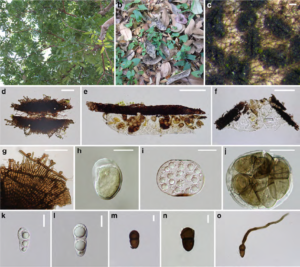Lembosia xyliae X.Y. Zeng & K.D. Hyde.
Index Fungorum number: IF551345; Facesoffungi number: FoF00933; Fig. 1
Etymology: From the host Xylia on which the taxon was observed.
Holotype – MFLU 14-0004
Epiphytic on leaves, forming circular or irregular blackened areas on the host surface. Colonies epiphyllous, circular, dense, single to confluent. Hyphae superficial, straight to substraight, dark brown, branching alternate to opposite at acute to wide angles, reticulate. Appressoria 1 celled, alternate, straight to substraight, lateral, antrorse. Sexual morph: Thyriothecia (315-) 350 – 500 (−724) × 200 – 300 μm (x̄ = 400 × 250 μm, n = 20), elongate, dimidiate to tripartite, soft, dense, borne on the surface of mycelium. Asci 40 – 60 × 30 – 50 μm (x̄ = 50 × 40 μm, n = 30), 8 -spored, bitunicate, ellipsoid to subglobose, sessile. Ascospores (11-) 25 – 32 × (5-) 10 – 17 μm (x̄ = 28 × 13 μm, n = 30), 3 – 5 – seriate, hyaline, 2 – celled, constricted at the septum, obovoid to ellipsoid, lower cell slightly longer and narrower, with two oil drops in each cell when immature, becoming brown at maturity. Asexual morph: Undetermined.
Material examined − THAILAND, Chiang Rai, Mae Fah Luang University, on leaves of Xylia sp. (Fabaceae), 18 January 2014, XY Zeng (MFLU 14-0004, holotype).

Fig. 1 Lembosia xyliae (holotype) a Host b Habit c Ascomata on fallen dried leaves d Squash mount of ascoma e Ascoma in longitudinal section f Ascoma in cross section g Peridium h – j Immature to mature asci k – n Immature to mature ascospores o Germinating ascospore. Scale Bars: c – e = 100 μm, f – g = 50 μm, h – j = 20 μm, k – n = 10 μm.
